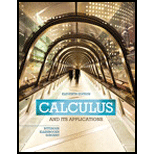
Concept explainers
Verify Property 2 of the definition of a probability density function for each of the functions in Exercises 1-12. Check using the answers to Exercises 1-12.
Want to see the full answer?
Check out a sample textbook solution
Chapter 5 Solutions
Calculus and Its Applications (11th Edition)
Additional Math Textbook Solutions
University Calculus: Early Transcendentals (4th Edition)
Single Variable Calculus: Early Transcendentals (2nd Edition) - Standalone book
Calculus: Early Transcendentals (2nd Edition)
Calculus, Single Variable: Early Transcendentals (3rd Edition)
- Example 2.1.1 Let S = R, and suppose P is a probability measure on R. Define F(x) by F(x) = P((-∞, x]), XER. (2.3) Then (i) F is right continuous,arrow_forwardPlease answer this one with solution. Let the function be as shown. If the first event is denoted by the interval (1,2) and the 2nd event is denoted by the interval (4,5). (a) Find the probability the probability of P(E1 U E2) (b) P(E1 ⋂ E2)arrow_forwardSection 2.6] Given the joint probability density function: (x(1+ 3y²) f(x,y) = 0 < x < 2,0 < y<1 4 otherwise a. Find f(x|y) b. Find P (< x < |Y = )arrow_forward
- In 1938, a physicist named Frank Benford discovered that the number 1 appears in the first digit of random data more often than the number 2, the number 2 more often than the number 3 and so on. In general, the probability of occurrence of the first digit of a number can be written in the form of a probability function x + 1 P(X = x) = log. X a. Prove it P(X = x) = log ) untuk x = 1,2,3,4...,9 x+1 X x = 1,2,3,4..., 9 is a probability mass function 2 b. Find the cumulative distribution function of X!arrow_forwardVerify Property 2 of the definition of a probability density function over the given interval. 1 10 f(x)= [4,6]arrow_forwardWould like to ask part d) and part e). Already know a) is 1-exp(-t), b) is exp(-h(x)), c) is exp(-h(x))*h(x), please do not answer these 3 parts again. Thank you!arrow_forward
- What do the functions Y. YY look like? Are there any maximum or 1+1 minimum probability at any particular angle(s) for these functions? [You don't have to prove this mathematically if you can provide your reasoning clearly.]arrow_forwardIn the transmission of digital information, the probability that a bit has high, moderate, and low distortion is 0.01, 0.04, and 0.95, respectively. Suppose that three bits are transmitted and that the amount of distortion of each bit is assumed to be independent. Let X and Y denote the number of bits with high and moderate distortion out of the three, respectively. Determine: E(x) =arrow_forwardIn Exercises 1-12, verify Property 2 of the definition of a probability density function over the given interval. 1. f(x) = 2x, [0, 1] 3. f(x) = 3, [0,] 5. f(x) = x?, [1,3] 2. f(x) = x, [1, 3] 4. f(x) = }. [3,8] 6. f(x) = , [0, 4] 7. f(x) = - (1, e]arrow_forward
- Algebra & Trigonometry with Analytic GeometryAlgebraISBN:9781133382119Author:SwokowskiPublisher:Cengage
 Big Ideas Math A Bridge To Success Algebra 1: Stu...AlgebraISBN:9781680331141Author:HOUGHTON MIFFLIN HARCOURTPublisher:Houghton Mifflin Harcourt
Big Ideas Math A Bridge To Success Algebra 1: Stu...AlgebraISBN:9781680331141Author:HOUGHTON MIFFLIN HARCOURTPublisher:Houghton Mifflin Harcourt

